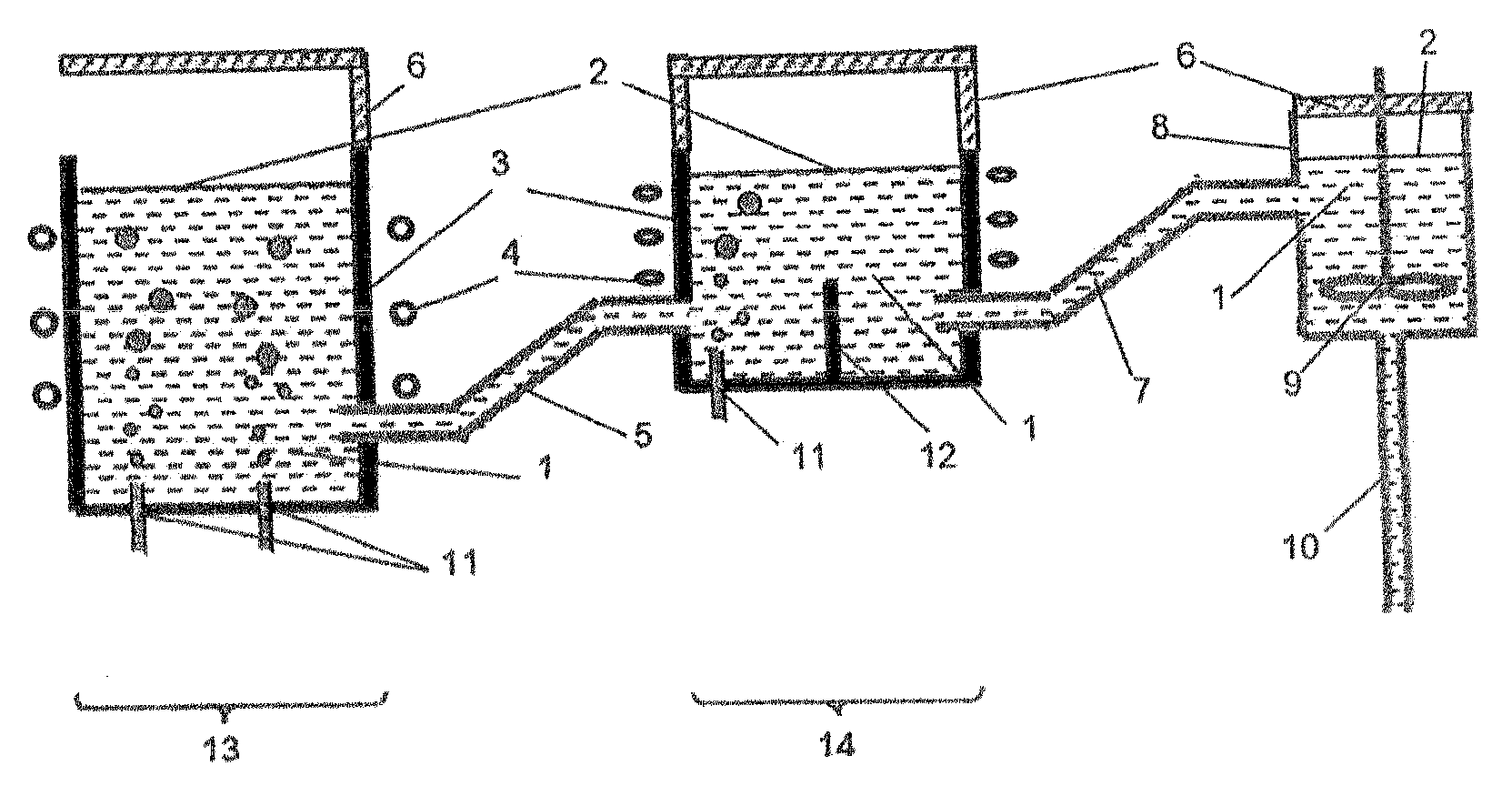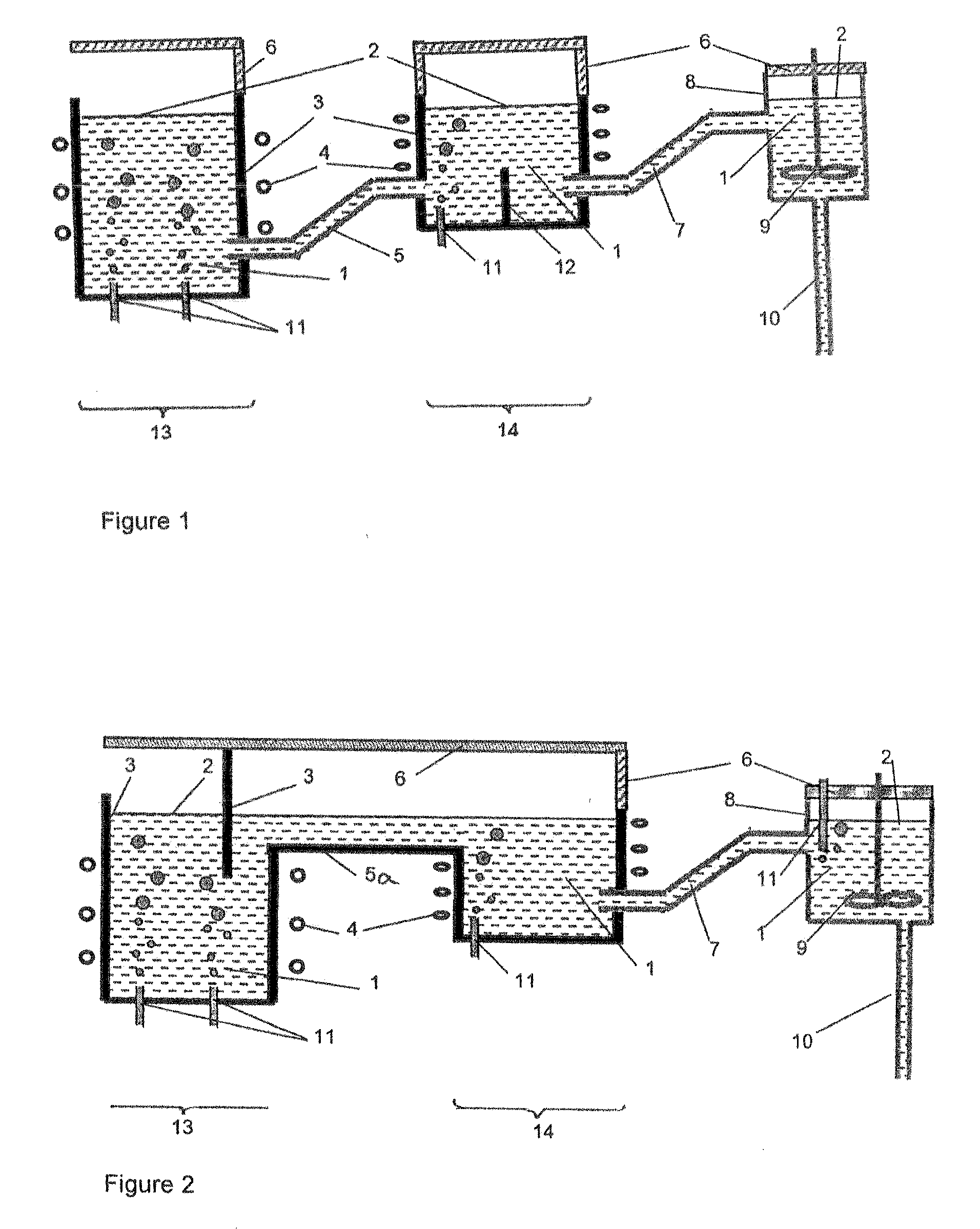Method and system for producing glass, in which chemical reduction of glass components is avoided
a technology of glass components and glass cylinders, applied in glass rolling apparatus, manufacturing tools, furnaces, etc., can solve the problems of uneconomic production, unfavorable production, and reduced production efficiency in conventional systems, and achieve the effect of reducing the reduction-sensitive components of glass and high refractive index
- Summary
- Abstract
- Description
- Claims
- Application Information
AI Technical Summary
Benefits of technology
Problems solved by technology
Method used
Image
Examples
example 1
[0079]A glass of the following composition was produced:
P2O5: 21.0%
ΣNb2O5, Ta2O5, Sb2O3: 50.5%
ΣMgO, CaO, SrO, BaO: 19.0%
ΣLi2O, Na2O, K2O, Rb2O, Cs2O: 4.5%
ΣZnO, TiO2: 5.0%
[0080]A melting skull crucible and a fining skull crucible consisting of AlMgSi1, connection segment, homogenization unit, agitator and feeder consisted of PtIr1 were used in the process.
[0081]The following melting parameters were used:
Melting: 1200° C.-1210° C., O2-Bubbling: 3×50 l / h
Fining: 1220° C.-1230° C., O2-Bubbling: 2×20 l / h
Mixing: 1180° C.
Feeder: 1150° C.
[0082]Ingots were produced.
[0083]The following optical values were measured:
nd=1.92773;
vd=20.61;
ΔPg,F=−0.0312
[0084]τi (400 nm; 25 mm)=0.104; 0.0021; 0.1152
τi (420 nm; 25 mm)=0.435; 0.2321; 0.4952
τi (460 nm; 25 mm)=0.812; 0.7481; 0.8462
τi (500 nm; 25 mm) 0.898; 0.8581; 0.9322
[0085]The given reference values (1) have been measured in a glass of the same composition that has been melted in a melting skull crucible made of AlMgSi1 at 1210° C. and fined in a ...
example 2
[0087]A glass of the following composition was produced:
P2O5: 22.8%
ΣNb2O5, Ta2O5, Sb2O3: 47.0%
ΣMoO3, WO3: 14.0%
ΣMgO, CaO, SrO, BaO: 2.0%
ΣLi2O, Na2O, K2O, Rb2O, Cs2O: 9.2%
ΣTiO2, GeO2: 5.0%
[0088]A melting skull crucible and a fining skull crucible consisting of AlMgSi1, connection segment, cooling duct, homogenization unit, agitator and feeder consisted of PtIr1 were employed in the process.
[0089]The following melting parameters were adjusted:
Melting: 1110° C.-1120° C., O2-Bubbling: 3×30 l / h
Fining: 1130° C.-1150° C., O2-Bubbling: 2×150 l / h
Mixing: 1110-1120° C.
Feeder: 1100° C.
[0090]Ingots were produced.
[0091]The following optical values were measured:
nd=1.97242;
vd=22.65;
ΔPg,F=0.0223
[0092]τi (400 nm; 25 mm)=0.070 (0.06)
τi (420 nm; 25 mm)=0.423 (0.36)
τi (500 nm; 25 mm)=0.875 (0.668)
[0093]The reference values given in brackets have been measured in a glass of the same composition that has been melted in a melting skull crucible made of AlMgSi1 at 1120° C. and fined in a conventional finin...
example 3
[0094]A glass for optical and electronic purposes of the following composition was produced:
ΣB2O3, SiO2: 10.5%
ΣSb2O3, Bi2O3: 77.0%
ΣMgO, CaO, ZnO: 12.5%
[0095]A melting skull crucible, connection segment, cooling duct and feeder consisting of PtIr1 were used.
[0096]The following melting parameters were adjusted:
Melting: 1000° C.-1050° C., O2-Bubbling: 3×50 l / h
[0097]Cooling track: 900-950° C.
Feeder: 850° C.
[0098]Glass flakes were produced.
[0099]The following optical values were measured:
nd=2.101
PUM
| Property | Measurement | Unit |
|---|---|---|
| widths | aaaaa | aaaaa |
| widths | aaaaa | aaaaa |
| slit widths | aaaaa | aaaaa |
Abstract
Description
Claims
Application Information
 Login to View More
Login to View More - R&D
- Intellectual Property
- Life Sciences
- Materials
- Tech Scout
- Unparalleled Data Quality
- Higher Quality Content
- 60% Fewer Hallucinations
Browse by: Latest US Patents, China's latest patents, Technical Efficacy Thesaurus, Application Domain, Technology Topic, Popular Technical Reports.
© 2025 PatSnap. All rights reserved.Legal|Privacy policy|Modern Slavery Act Transparency Statement|Sitemap|About US| Contact US: help@patsnap.com



